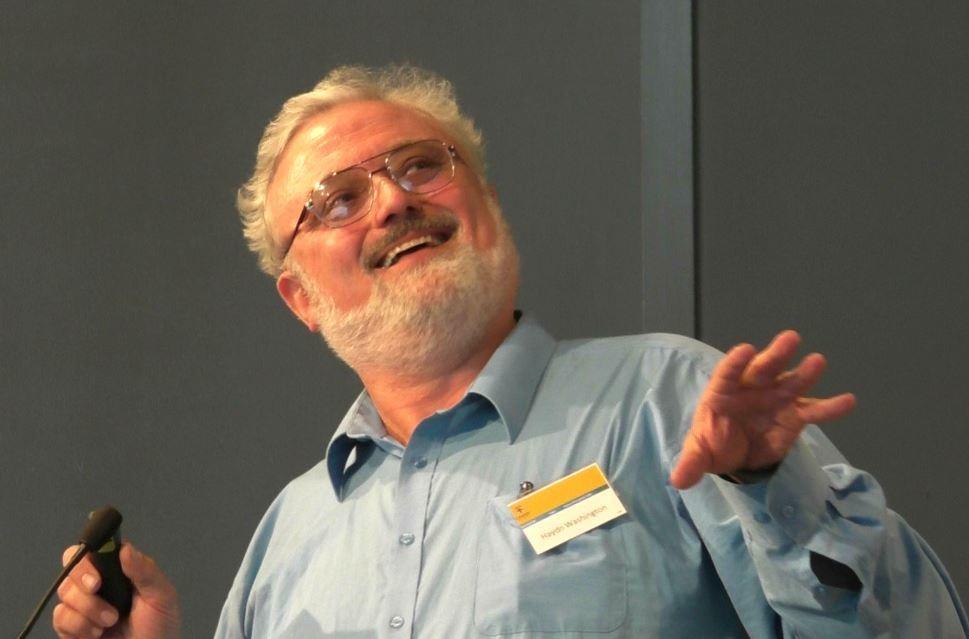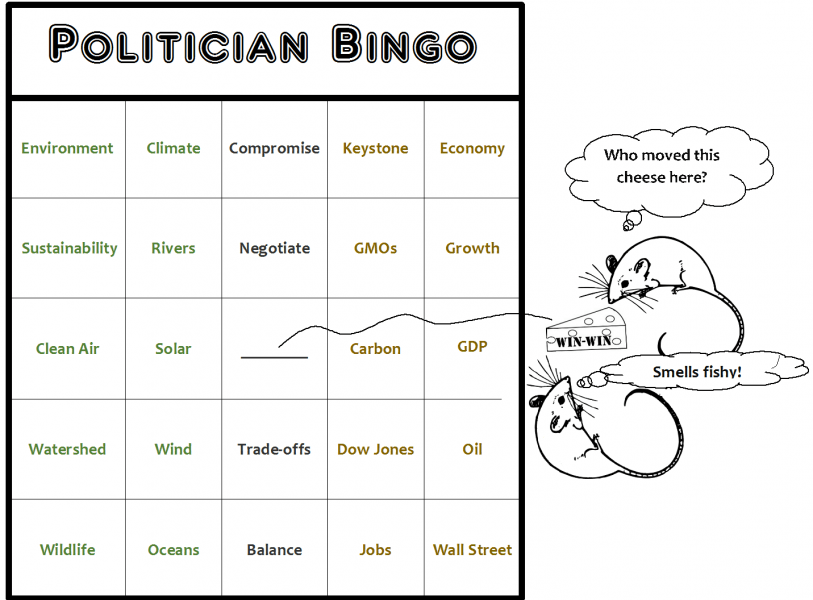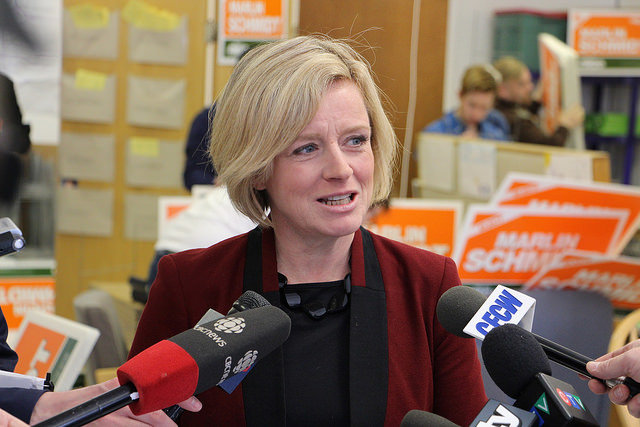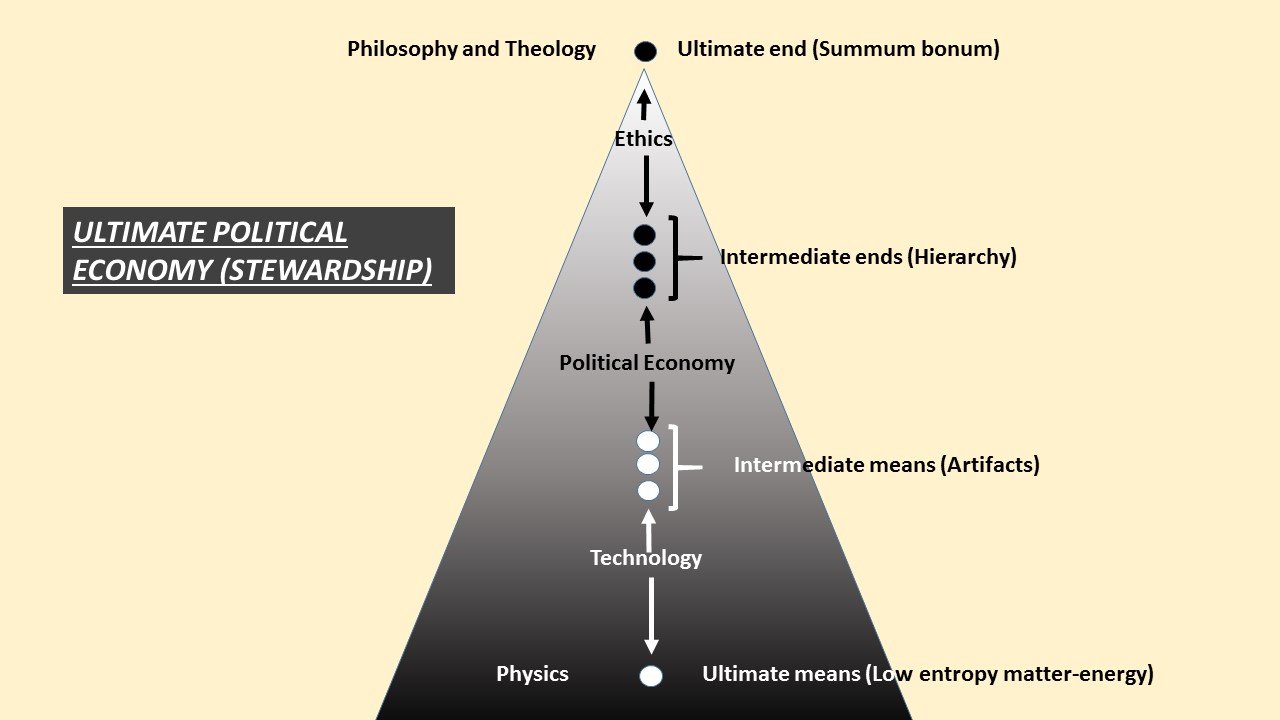Setting Things Straight for the Steady State
by Brian Czech
Extremely dangerous political rhetoric has proliferated over the past several decades, seducing the masses onto a path that leads to the destruction of nature and civilization. This rhetoric is centered on the claim that “there is no conflict between growing the economy and protecting the environment!” Politicians are all about economic growth but, at the same time, none of them want to be seen as willful destroyers of the environment. Therefore they stretch, warp, and corrupt the truth with the win-win rhetoric that we can have our cake and eat it too.
Such is the world that CASSE—the Center for the Advancement of the Steady State Economy—was born into on May 1, 2004. In fact, the win-win rhetoric about growing the economy while protecting the environment was the primary impetus for establishing CASSE. The CASSE position on economic growth sets the record straight that “there is a fundamental conflict between economic growth and environmental protection,” leading up to this fact with seven “whereas” clauses and following it with eight other “therefore” findings.
Those having a counter-reaction that “there doesn’t have to be a conflict; it’s not a fundamental conflict” should read the full CASSE position. The fundamentality of the conflict between economic growth and environmental protection stems from the first two laws of thermodynamics. “Laws of thermodynamics” might sound intimidating to the uninitiated, yet the first two laws can be summarized in such common-sensical terms as: Law 1) You can’t get something from nothing; Law 2) You can’t be 100% efficient in the production process. These laws set up a limit to economic growth, as well as the fundamental conflict between economic growth and environmental protection, as evidenced most clearly by the erosion of biodiversity in lockstep with economic growth.

Haydn Washington, co-editor of A Future Beyond Growth and co-director of the NSW chapter of CASSE, speaking at the Australian Academy of Science’s 2014 Fenner Conference on the Environment. (Credit: Anna Schlunke)
So read the CASSE position, and read this book. While the relationship between economic growth and environmental protection is not an overly simple matter, the key points are readily grasped by sober readers, with the benefit of a clearly written book such as A Future Beyond Growth.
Among the 13,000 signatories of the CASSE position are some of the world’s leading sustainability thinkers, including authors of A Future Beyond Growth. Over 200 organizations have endorsed the position. Despite growing support for its central position, CASSE has been David to the Goliaths of Wall Street, neoclassical economics, and mainstream politics worldwide. Economic growth remains the top domestic policy goal among nations and lesser states as well, even as it causes more problems than it solves in the 21st century.
Of course if you’re going to be a responsible critic of economic growth, much less a long-lasting one, you better have an alternative to offer. Fortunately it is easy to identify the basic alternatives to growth. There are but two: economic degrowth and the steady state economy. The best way to summarize the alternatives is with a reminder of what, precisely, is meant by “economic growth.”
Economic growth is simply increasing production and consumption of goods and services in the aggregate. It entails increasing population and/or per capita consumption. Economic growth is indicated by increasing gross domestic product, or GDP. It entails higher demand for materials and energy, because “you can’t get something from nothing.”
Economic growth should be distinguished from “economic development,” which refers to qualitative change regardless of quantitative growth. For example, economic development may refer to the attainment of a fairer distribution of wealth, or a different allocation of resources reflecting the evolution of consumer ethics.
Degrowth, then, is simply defined as decreasing production and consumption in the aggregate, as indicated by decreasing GDP. Decreasing population and/or per capita consumption is required. The word “degrowth” tends to have political connotations in addition to meaning a smaller economy, especially in Western Europe where the degrowth movement originated as “La Décroissance.” (Frankly, “economic growth” also has marked political connotations, but society has gotten numb to them.) As with economic growth, degrowth in the sense of a shrinking economy is ultimately unsustainable.
The sustainable alternative to unsustainable growth and degrowth is the steady state economy, which has stabilized production and consumption of goods and services in the aggregate. “Stabilized” in this context means mildly fluctuating. A steady state economy has stabilized population and per capita consumption. Energy and material demands are gradually stabilized—in the aggregate and per capita—as the limits to productive efficiency are reached. All else equal, a steady state economy is indicated by stabilized GDP. The “all else equal” (as I described in Supply Shock: Economic Growth at the Crossroads and the Steady State Solution) includes level of technology, inflation, the propensity to use money relative to other means of exchange, and environmental conditions. But the bottom line, so to speak, is that GDP is a fine indicator of one thing: the pure size of the economy. Which makes it a good indicator of one other thing: environmental impact.
Obviously the pursuit of a steady state economy invokes a thousand devils in the details of political and cultural reforms. Macroeconomic goals, tax codes, budgets, interest rates, terms of trade: these are some of the aspects of statecraft to be dramatically overhauled with steady statesmanship. In the private sector, what about the sociology of consumption? Imagine the attitudes toward conspicuous consumption in a world that finally gets it about limits to growth.
A basic measure of justice, with an equally basic measure of logic, suggests that the place to start in moving toward a steady state economy on Earth is with the wealthiest nations. Impoverished nations need economic growth, almost by definition. We all know who the wealthiest nations are—look for example at nighttime lighting imagery—and concerned citizens from these countries have helped raise awareness of the perils of pursuing perpetual growth.
Which brings us back to CASSE, the uphill-fighting, philanthropically disadvantaged, non-governmental organization with the mission of advancing the steady state economy, with stabilized population and consumption, as a policy goal with widespread public support. CASSE is almost entirely a volunteer organization. Its “business model” should be referenced in quotes, as “business” tends to connote things like money, salaries, contracts, and related financial features that are rare in the context of CASSE. But CASSE has a volunteer model that includes international chapters unified by the CASSE position on economic growth.
CASSE’s New South Wales Chapter, led by Haydn Washington and Anna Schlunke, has demonstrated the potential of this volunteer model. When they invited me to give the keynote address at the Australian Academy of Science’s 2014 Fenner Conference (the AAS’s annual environmental conference), with the conference’s theme being the steady state economy, I had to check if it was April Fool’s Day. To convene a major academy on the steady state economy in the United States, where Big Money calls the shots even in “academic” affairs, would have been inconceivable. The fact that the CASSE New South Wales Chapter (and its partners) managed to deliver the goods on a national academy conference for the steady state economy says a lot about the New South Wales CASSE chapter, the Australian Academy of Science, and even Australia itself.
What exactly does it say? For starters, it says Haydn Washington and Anna Schlunke are diligent scholars, determined organizers, and capable communicators. It says that the Australian Academy of Science is a faithful champion of its scientific communities. It suggests, too, that an inquisitive, open-minded spirit prevails at least in Australia, which offers hope to the international community. Open minds in Australia have gleaned crucial insights from CASSE’s tireless Australian National Director, Geoff Mosley (Melbourne), and from one of the world’s leading steady state economists, Philip Lawn (Adelaide), and other Australians who presented at the 2014 Fenner Conference.
A Future Beyond Growth grew out of the proceedings of the 2014 Fenner Conference on the Environment. Not everything from the conference made it to print. My own talk, for example, stays mostly in the pages of Supply Shock, plus the current prefatory remarks. But much of the highly memorable Fenner Conference is presented herein, and I feel delighted to preface the chapters with one more thing:
The next time you hear the win-win spin that “there is no conflict between growing the economy and protecting the environment” or the equivalent in your regional culture, don’t just throw up your hands in resignation to the rhetoric. Think instead about a future beyond growth. That’s where there’s no conflict with protecting the environment, national security, and international stability.
Editor’s Note: The forthcoming A Future Beyond Growth (Routledge, 2016), edited by Haydn Washington and Paul Twomey, explores the vision and process for moving toward a steady state economy. This edited volume stemmed from the Australian Academy of Science’s 2014 Fenner Conference on the Environment. Haydn is the co-director of the New South Wales chapter of CASSE. The following is Brian Czech’s foreword to “A Future Beyond Growth.”








A steady state economy is a certainty, but not in the way this article sets it out—that somehow we will be able to decide on it as an act of political or communal will, where everyone calmly accepts the inevitability of it. There is also something highly suspect about any group of ‘academics’ proposing a steady state in anything.
A steady state cannot exist in nature, no matter how much we might want it to. Everything is ultimately in a state of entropy, and requires energy input to offset that. But ‘steady state’ does not allow for energy input. We are left then with academic indulgence in wish-politics, wish-science and wish-economics, with no grounding in reality. Humankind will not willingly surrender to a ‘steady state’ even if that were possible. We have been conditioned to consume, and have been doing that for countless millennia. The last 250 years has given our instinct for consumption a massive boost, but it hasn’t changed what we are. We think of ‘now’ as permanent, because the industrial revolution brought us a life of ease, increasing food supplies, luxuries beyond the dreams of avarice, good health and full bellies—to list but a few. Before the Industrial Revolution, we had a more or less steady state economy. That gave us the exact opposite: disease, unreliable food supplies, and a life expectancy of about 50. Forget the ramblings of academic thinkers for a moment. We have an expectation that our current lifestyle is going to continue into infinity—just like we’ve been promised. Sure, we subconsciously know that the idea of infinite growth is nonsense, but by the same token, it only applies to other people; the Chinese maybe, or somesuch place 10000 miles away. Our political leaders tell convincing lies about infinite growth, renewable energy and that technology will solve any minor difficulties, so we vote for their promised prosperity. Like countless millions, we look on prosperity as something that can be voted into office. We find that comforting, far more so than the words of ‘academic thinkers’ who say the party’s over. After all, supermarket shelves are still full, gas is still at filling stations and planes are still in the air. So where’s the problem?
I’m trying to put over the inevitable violent reaction of Joe Average, at being told his life is going to be controlled into a ‘steady state’. Economic growth is over, and what he has now is all there’s going to be. Ever. His kids have reached a dead end before they even get there. Their future is over too.
So who is going to do the controlling? he asks. Let’s not be under any illusions here. Any attempt to bring about a ‘steady state’ economy makes control a certainty. And that means a form of dictatorial government because you will have instant revolt against it. It is a problem that cannot be solved by political means, but Joe Average thinks that it can, the political wrangling will continue over the means of control. That will bring about civil unrest. If you have civil unrest, you need martial law to control it. That will throw up a dictator. No dictator in the history of mankind has ever been anything other than a self seeking despot, appropriating power for himself and his immediate tribe. In the USA in particular, that’s likely to be a theocracy. Need I go on?
Mr Average will reject any form of control as being contrary to his human right to consume anything and everything he chooses. Deny that all you want, but so far we are well advanced in the process of setting fire to our planet in order to keep warm, fed, cool, and circumvent the laws of gravity. So far I see no slowing down of that in real terms. Only political platitudes and promises of yet more ‘growth.’
Norman raises many valid points. They all hinge upon exactly how people interpret words like “economic growth” and “steady state economy”. Without considerable explanation, most people are likely to walk away with the wrong idea, entirely.
In my experience, it is difficult to get “Joe Average” (or “Josephine Average”) to work their way through the details of a nontrivial matter. Indeed, from my point of view there are many who contribute to the Daley News who haven’t really thought things through to my satisfaction.
There are real things that the steady state economists can contribute that “Joe” and “Josephine” will identify with, immediately. The most obvious are those many things that increase GDP but actually reduce the wellbeing of Mr/Mss Average. This is something that politicians are not immune to, in my experience. Unfortunately, they then go and ask an economist (or a banker, or the Chamber of Commerce) — and then we are back to square one.
Frankly, the words “steady state” leave me cold. In my view, the objective should be to improve wellbeing.
When we say “steady state” most people hear “sacrificing hope for a better life”.
In my view, all the actors on this “steady-state” stage understate the impact of overpopulation and aggrandize “economic theory” (be it steady state or otherwise).
at least one other person in the universe ”gets it”
we have 7 bn people here and alive now
within those 7 billion, are the mothers of the next 2 billion, either at or approaching reproduction age.
those mothers are not going to willingly forgo the right to reproduce themselves to achieve a steady state economy (women are like that)
On that basis then we are going to reach 9 billion plus because the elderly among us are not going to conveniently die either to make room for them. (As happened in our previous ‘steady state’ eras) we also quite rightly demand that every child survives to reproduce itself.
to bring a child to maturity takes a colossal input of energy over 20 years, which blows ‘steady state’ right out of the water.
But the planet cannot support 9 billion, because sufficient food cannot be grown to feed them, (forget houses and jobs for a moment) because by 2050 (say) there won’t be any oil to convert into food, so food grown will have to rely exclusively on sunlight.
this is where we get into head hurting stuff.—–
If we can’t feed 9 billion, but they insist on being fed, it follows then that violent conflict is inevitable. The haves will not downgrade their lifestyle to alleviate the predicament of the have nots.. So the have nots will rise up to take it.
If you doubt that, look at what’s starting to happen on Europe’s southern borders right now. Then Imagine Africa with another half billion people looking at Europe’s full supermarkets. You aint seen nothin yet folks! Try telling them they need ‘a steady state economy!’